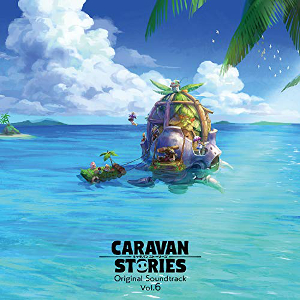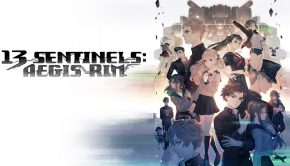Caravan Stories Original Soundtrack Vol. 6
 |
Album Title: Caravan Stories Original Soundtrack Vol. 6 |
| Record Label: Basiscape Records |
|
| Catalog No.: BSPE-1076 |
|
| Release Date: November 30, 2018 |
|
| Purchase: Buy at iTunes |
Overview
Caravan Stories is a mobile/PC MMORPG released by Aiming in 2017 and features the talents at Basiscape helming the music. The Caravan Stories Original Soundtrack Vol. 6 is the sixth of eight planned releases that will span through January 2019. Featuring the music from Basiscape veterans Yoshimi Kudo and Mitsuhiro Kaneda, in addition to relative newcomers, Kazuki Higashihara and Rikako Watanabe, who headlines the album, what type of sound can be heard on this volume, which focuses on the elf areas of the game?
Body
The album opens with Rikako Watanabe’s “Narupopo Village,” starting with a beautiful piano passage before incorporating ethereal atmospheric synths, flute, woodblock percussion, and strings. The overall atmosphere is quite relaxing and the melody is also quite enjoyable, even if some aspects like the synthesized strings are a bit lacking compared to other albums. Her other town theme contribution, “Marupopo Root City” gives off a more tropical vibe with marimba and bright woodwinds, yet having a revered feeling in the strings, all of which support a beautiful melody. The battle theme, “Laurara’s Dance” is bright and jovial full of woodwinds, woodblock percussion, strings, and accordion. The woodwind melody, in particular, is quite nice and the end result has a very fantasy sound. Of particular note is the piano section that appears in the bridge before the loop. Surprisingly, the mine theme for this area, “Canyari Mine,” is done by Watanabe rather than Higashihara. While it certainly carries the influence of other mine sections previously released, it is a more melodically focused affair with strings, woodwinds, and accordion that really manages to draw the listener in. Previously heard in part on Vol. 1 is “Iyarr’s Narrator,” “Iyarr’s Narrator” is a whimsical, and somewhat tense tune full of woodwinds, strings, and piano, with a decent melody, but doesn’t quite standout.
The remaining contributions from Watanabe are all area themes. “Temple of Pakama” is a mallet percussion forward tune full of marimba and bright woodwinds, giving the soundscape a very tropical vibe. It’s a jovial and fun tune with an enjoyable melody, however, there are some minor additions, such as bagpipes, that feel wholly unnecessary and feel out of place in the track as they are only present for a brief section prior to the loop. The “Nightscape” version is largely a mysterious woodwind and piano driven version with a soft sound. In addition, glockenspiel and some synth work give a peaceful vibe. “Narupopo Fruit Garden” is another relaxing tune with a beautiful melody, particularly in the B section, when the woodwinds and piano really manage to shine. This combination, alongside the mallet percussion, helps give it a bit of a tropical vibe. The “Nightscape” version is more piano focused with a more ethereal and atmospheric feel, in particular, due to the incorporation of synthesizer in the accompaniment. There is an otherworldly feeling to it and the general atmosphere of the piece is outstanding. “Urdon Beastland” is a percussion focused tune with woodwinds and plucked strings. The sound of the tune is quirky overall, but is not too memorable melodically or atmospherically speaking. However, “Chaktek Great Rift Valley” is adventurous and playful with its strings and woodwinds, respectively. The melody itself is also quite beautiful. However, the “Nightscape” version is where the melody really shines. Synths accompany haunting piano while the woodwinds with their airy sound help drive the atmosphere. The surprise addition of a horn in the lead is a welcome touch while the jazzy tone gives a nice musical texture to the piece.
The supporting players on the soundtrack, Kazuki Higashihara, Mitsuhiro Kaneda, and Yoshimi Kudo, round out the other half of the soundtrack. Higashihara, responsible for a set of area themes, with the day and night versions of “Nunnari Rice Terraces.” The former provides a Japanese aesthetic, at times, with woodwinds, cello, and hand percussion providing a quaint and playful sound while the latter is a more peaceful rendition more strings/woodwind oriented with less of a percussion focus. Mitsuhiro Kaneda’s sole contribution is that of a battle theme, “Battle Against Leviathan,” a dramatic and intense choral/orchestral tune. Although it has a nice melody, it isn’t particularly exciting and sounds like a standard style Basiscape battle tune rather than some of the more unique battle themes Kaneda typically provides. Yoshimi Kudo provides two renditions of “Caravan Trip.” The first, “Caravan Trip -South-” is more folksy in approach with piccolo, percussion, and plucked strings. There is also some Japanese aesthetic provided in the instrumentation and overall implementation. It’s a decent tune, but not a favorite rendition. The other rendition, “Caravan Trip -Holy Festival-,” provides a more angelic feel to the tune with strings, chimes, choir, piano, and woodwind.
The remaining Kudo tunes are some miscellaneous tunes and the album’s vocal, in short and full variety. “A Wild Kid in a Great Island” is a tune that focuses a lot on percussion and woodwinds. The end result is quite quirky and has an exotic sound. “A Fighter of Wakok” has a very Basiscape sound with woodwinds, strings, and shamisen giving it a very Japanese inspired sound with an honorable atmosphere and reminiscent of Oboromuramasa. Likewise, “Sword Fight” would fit right into Oboromuramasa with its shamisen focus, exhilarating strings and percussion, contrasted nicely by bright woodwind passages. The vocal theme, “Coraggioso! Coraggiosamente!,” however, is the biggest surprise of the album. It’s an operatic orchestral tune with a very classical sound. Bright strings and woodwind passages support a fun vocal percussion and the end result is extremely catchy. It’s certainly my favorite vocal theme for the series yet.
Summary
The Caravan Stories Original Soundtrack Vol. 6 is another great entry in the series of soundtracks being released dedicated to the music of Caravan Stories. Rikako Watanabe does a respectable job at setting the tone for the Gessy areas in the game, most of which have a tropical vibe to them. While there are some less than stellar sounding synths used, particularly in the strings, it isn’t too distracting. The supporting composers help round out the release, but aren’t as enthralling as past entries. There are some beautiful tunes, such as the vocals, but some of the others lack the creativity of their previous entries. In the end, fans of the series will certainly find something to enjoy and it gives a more in-depth look at one of Basiscape’s newest composers.
Do you agree with the review and score? Let us know in the comments below!
4
Posted on December 11, 2018 by Don Kotowski. Last modified on December 11, 2018.














